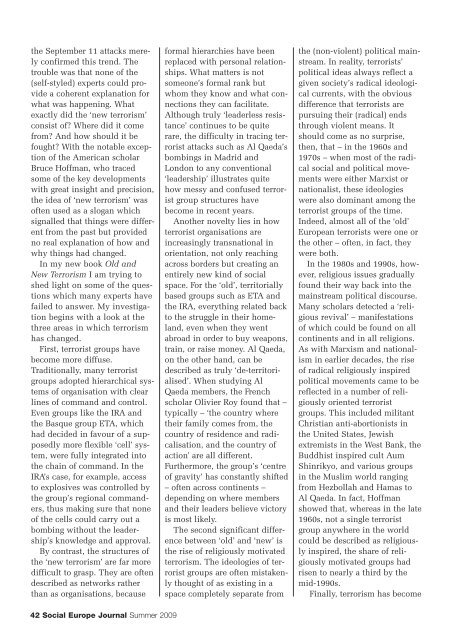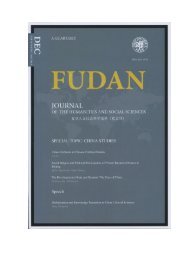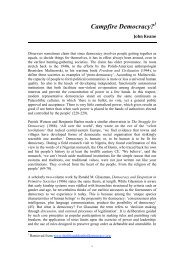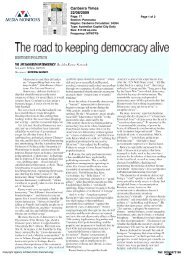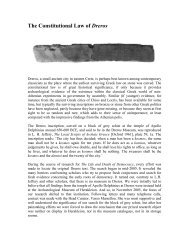The Ethics of Capitalism - Social Europe Journal
The Ethics of Capitalism - Social Europe Journal
The Ethics of Capitalism - Social Europe Journal
Create successful ePaper yourself
Turn your PDF publications into a flip-book with our unique Google optimized e-Paper software.
the September 11 attacks merely<br />
confirmed this trend. <strong>The</strong><br />
trouble was that none <strong>of</strong> the<br />
(self-styled) experts could provide<br />
a coherent explanation for<br />
what was happening. What<br />
exactly did the ‘new terrorism’<br />
consist <strong>of</strong> Where did it come<br />
from And how should it be<br />
fought With the notable exception<br />
<strong>of</strong> the American scholar<br />
Bruce H<strong>of</strong>fman, who traced<br />
some <strong>of</strong> the key developments<br />
with great insight and precision,<br />
the idea <strong>of</strong> ‘new terrorism’ was<br />
<strong>of</strong>ten used as a slogan which<br />
signalled that things were different<br />
from the past but provided<br />
no real explanation <strong>of</strong> how and<br />
why things had changed.<br />
In my new book Old and<br />
New Terrorism I am trying to<br />
shed light on some <strong>of</strong> the questions<br />
which many experts have<br />
failed to answer. My investigation<br />
begins with a look at the<br />
three areas in which terrorism<br />
has changed.<br />
First, terrorist groups have<br />
become more diffuse.<br />
Traditionally, many terrorist<br />
groups adopted hierarchical systems<br />
<strong>of</strong> organisation with clear<br />
lines <strong>of</strong> command and control.<br />
Even groups like the IRA and<br />
the Basque group ETA, which<br />
had decided in favour <strong>of</strong> a supposedly<br />
more flexible ‘cell’ system,<br />
were fully integrated into<br />
the chain <strong>of</strong> command. In the<br />
IRA’s case, for example, access<br />
to explosives was controlled by<br />
the group’s regional commanders,<br />
thus making sure that none<br />
<strong>of</strong> the cells could carry out a<br />
bombing without the leadership’s<br />
knowledge and approval.<br />
By contrast, the structures <strong>of</strong><br />
the ‘new terrorism’ are far more<br />
difficult to grasp. <strong>The</strong>y are <strong>of</strong>ten<br />
described as networks rather<br />
than as organisations, because<br />
formal hierarchies have been<br />
replaced with personal relationships.<br />
What matters is not<br />
someone’s formal rank but<br />
whom they know and what connections<br />
they can facilitate.<br />
Although truly ‘leaderless resistance’<br />
continues to be quite<br />
rare, the difficulty in tracing terrorist<br />
attacks such as Al Qaeda’s<br />
bombings in Madrid and<br />
London to any conventional<br />
‘leadership’ illustrates quite<br />
how messy and confused terrorist<br />
group structures have<br />
become in recent years.<br />
Another novelty lies in how<br />
terrorist organisations are<br />
increasingly transnational in<br />
orientation, not only reaching<br />
across borders but creating an<br />
entirely new kind <strong>of</strong> social<br />
space. For the ‘old’, territorially<br />
based groups such as ETA and<br />
the IRA, everything related back<br />
to the struggle in their homeland,<br />
even when they went<br />
abroad in order to buy weapons,<br />
train, or raise money. Al Qaeda,<br />
on the other hand, can be<br />
described as truly ‘de-territorialised’.<br />
When studying Al<br />
Qaeda members, the French<br />
scholar Olivier Roy found that –<br />
typically – ‘the country where<br />
their family comes from, the<br />
country <strong>of</strong> residence and radicalisation,<br />
and the country <strong>of</strong><br />
action’ are all different.<br />
Furthermore, the group’s ‘centre<br />
<strong>of</strong> gravity’ has constantly shifted<br />
– <strong>of</strong>ten across continents –<br />
depending on where members<br />
and their leaders believe victory<br />
is most likely.<br />
<strong>The</strong> second significant difference<br />
between ‘old’ and ‘new’ is<br />
the rise <strong>of</strong> religiously motivated<br />
terrorism. <strong>The</strong> ideologies <strong>of</strong> terrorist<br />
groups are <strong>of</strong>ten mistakenly<br />
thought <strong>of</strong> as existing in a<br />
space completely separate from<br />
the (non-violent) political mainstream.<br />
In reality, terrorists’<br />
political ideas always reflect a<br />
given society’s radical ideological<br />
currents, with the obvious<br />
difference that terrorists are<br />
pursuing their (radical) ends<br />
through violent means. It<br />
should come as no surprise,<br />
then, that – in the 1960s and<br />
1970s – when most <strong>of</strong> the radical<br />
social and political movements<br />
were either Marxist or<br />
nationalist, these ideologies<br />
were also dominant among the<br />
terrorist groups <strong>of</strong> the time.<br />
Indeed, almost all <strong>of</strong> the ‘old’<br />
<strong>Europe</strong>an terrorists were one or<br />
the other – <strong>of</strong>ten, in fact, they<br />
were both.<br />
In the 1980s and 1990s, however,<br />
religious issues gradually<br />
found their way back into the<br />
mainstream political discourse.<br />
Many scholars detected a ‘religious<br />
revival’ – manifestations<br />
<strong>of</strong> which could be found on all<br />
continents and in all religions.<br />
As with Marxism and nationalism<br />
in earlier decades, the rise<br />
<strong>of</strong> radical religiously inspired<br />
political movements came to be<br />
reflected in a number <strong>of</strong> religiously<br />
oriented terrorist<br />
groups. This included militant<br />
Christian anti-abortionists in<br />
the United States, Jewish<br />
extremists in the West Bank, the<br />
Buddhist inspired cult Aum<br />
Shinrikyo, and various groups<br />
in the Muslim world ranging<br />
from Hezbollah and Hamas to<br />
Al Qaeda. In fact, H<strong>of</strong>fman<br />
showed that, whereas in the late<br />
1960s, not a single terrorist<br />
group anywhere in the world<br />
could be described as religiously<br />
inspired, the share <strong>of</strong> religiously<br />
motivated groups had<br />
risen to nearly a third by the<br />
mid-1990s.<br />
Finally, terrorism has become<br />
42 <strong>Social</strong> <strong>Europe</strong> <strong>Journal</strong> Summer 2009


